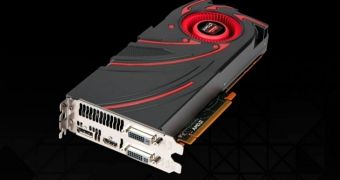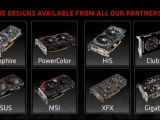If you tuned in to watch the AMD 30 Years of Graphics and Gaming Livestream on Saturday, August 23, you probably know everything AMD revealed on its first Tonga-based Radeon graphics card, but we have some more information to impart.
Specifically, we can tell you that the video card has been tested in 3DMark FireStrike and has proven to be quite powerful, even compared to the main competitor on the side of NVIDIA.
The board was installed on a personal computer whose heart was an Intel Core i7-4960X six-core central processing unit, backed by DDR3-1866 MHz memory.
In the 3DMark FireStrike benchmark, performance preset, the Radeon R9 285 video card scored P7066, while the Extreme Preset yielded X3153 points.
For comparison, the NVIDIA GeForce GTX 760, which the R9 285 is supposed to compete against, only scored P5650 and X2774, respectively, with the 337.88 WHQL driver installed.
Of course, since this wasn't a benchmark carried out by an independent reviewer, the numbers might be a bit iffy. Still, even if the difference isn't quite so great, it seems the Radeon R9 285 is, if nothing else, superior to its main competitor. The Sunnyvale company says the difference is of around 15%.
We'll leave it to you to decide if the small price advantage of NVIDIA's board ($239 / €249) offsets the performance disadvantage.
All this without actually using the 28nm Tonga graphics processing unit to its full potential. As we noted before, the GPU has 2,048 Graphics CoreNext stream processors (GCN SPs), but not all of them are used.
Now we can give you the exact number of active processors: 1,792. On that note, not all of the texture mapping units are active either. Which is to say, there are 112 TMUs available instead of 128. It seems that only the ROP count had been correct previously: 32 raster operating units.
AMD's reference graphics card has 2 GB of GDDR5 VRAM connected to the GPU through a 256-bit interface. However, the company's add-in-board partners will launch 4 GB cards as well.
As for the clock speeds, they are higher than we expected. The GPU itself operates at 918 MHz, while the VRAM works at 5.5 GHz instead of the 4.5 GHz some expected previously.
All the while, the Tonga-based Radeon R9 285 is as energy efficient as the NVIDIA GK104 Kepler-based GeForce GTX 760.
Sales of the AMD Radeon R9 285 and OEM-designed adapters will commence on September 2.

 14 DAY TRIAL //
14 DAY TRIAL // 

